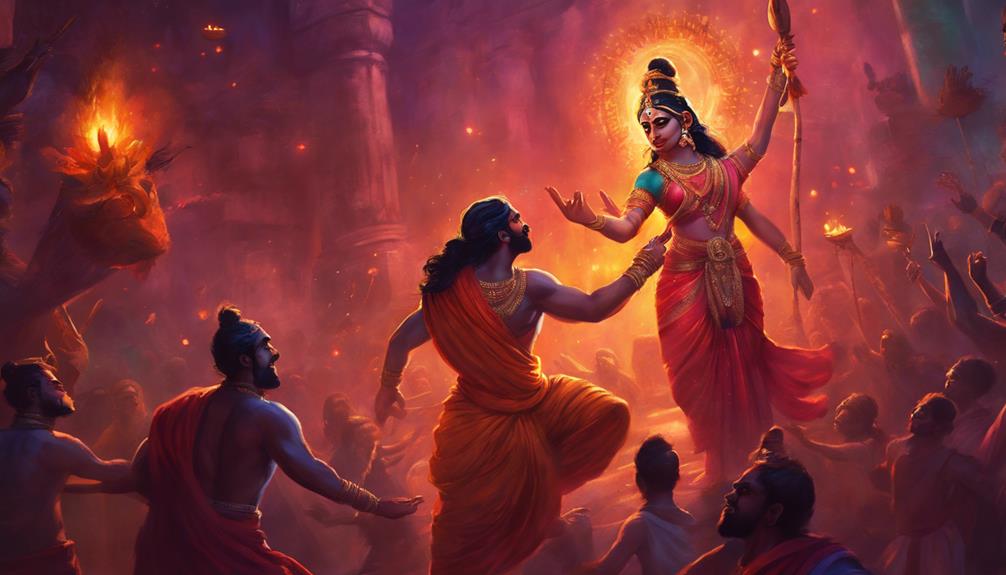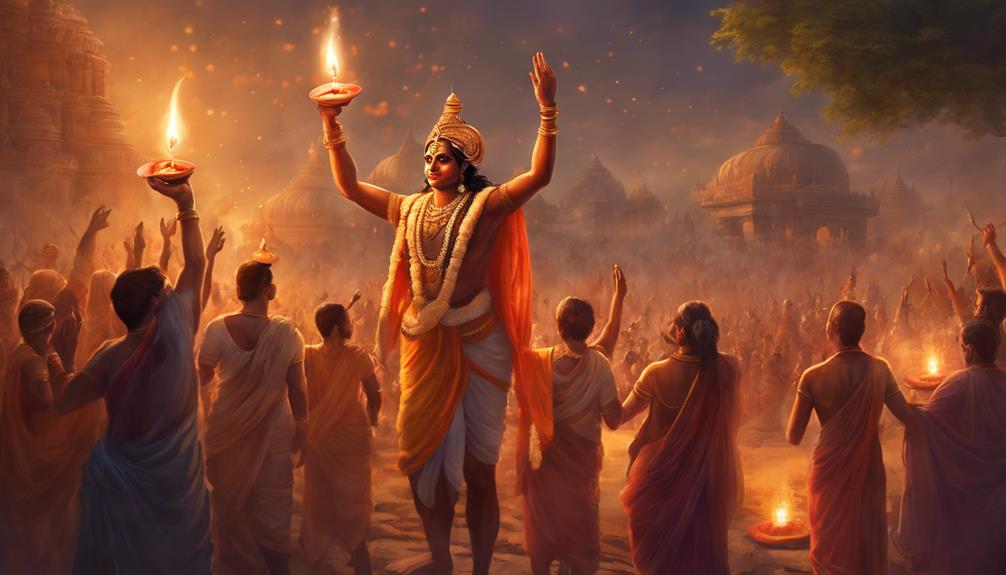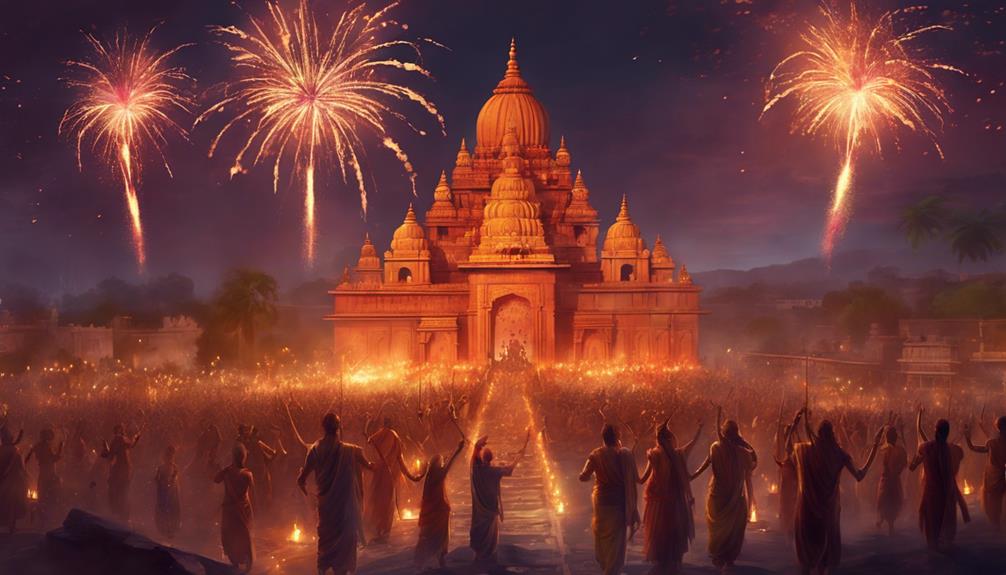Immerse yourself in the profound connection linking the Festival of Diwali to the revered Lord Rama. Diwali celebrates Rama's admirable resilience during exile and his return to Ayodhya, symbolizing light prevailing over darkness and the importance of upholding principles. It also commemorates Rama's victory over the demonic Ravana, showcasing his valor, divine grace, and leadership. This saga of triumph, righteousness, and the eternal battle between good and evil awaits your exploration.
Table of Contents
Key Takeaways
- Diwali celebrates Lord Rama's return to Ayodhya after exile.
- Rama's victory over Ravana symbolizes triumph of good over evil.
- Hanuman's devotion during Sita's abduction is honored during Diwali.
- Lighting lamps signifies victory of light and goodness.
- Diwali customs like Rangoli art and exchanging sweets connect to Rama's values.
The Story of Lord Ramas Exile
During his exile, Lord Rama faced numerous challenges and tests of his character and devotion to righteousness. The tale of Rama's exile is deeply intertwined with the Diwali celebration traditions. Banished to the forest for fourteen years, Rama, along with his devoted wife Sita and loyal brother Lakshmana, embraced their fate with grace and fortitude. Despite facing hardships and adversities during this period, Rama remained steadfast in his adherence to dharma, or righteousness.
The Diwali festival commemorates the return of Lord Rama to Ayodhya after his victorious exile. It symbolizes the triumph of light over darkness and good over evil. The exile of Rama serves as a poignant reminder of the importance of staying true to one's principles, even in the face of adversity. It's a time for introspection, self-reflection, and renewal of one's commitment to leading a righteous life, just as Lord Rama did during his exile.
Lord Ramas Victory Over Ravana
After a fierce battle, Lord Rama emerged victorious over the demon king Ravana, showcasing unparalleled valor and divine grace in the epic tale of their confrontation. Rama's leadership skills were prominently displayed as he led his army with strategic brilliance and unwavering determination. His unwavering commitment to righteousness and dharma inspired his troops, instilling in them a sense of purpose and courage.
Ravana's downfall was a result of his arrogance and disregard for moral principles. Despite his immense power and intelligence, his ego blinded him to the consequences of his actions. In contrast, Lord Rama's humility and adherence to his duties as a prince and warrior propelled him to victory. The battle between Rama and Ravana symbolizes the eternal struggle between good and evil, with Rama standing as a beacon of light and righteousness.
Through his triumph over Ravana, Lord Rama teaches us the importance of staying true to our values, leading with integrity, and facing challenges with unwavering determination.
Sitas Abduction and Rescue

When Sita was kidnapped by Ravana, it sparked a series of events that would test the strength and devotion of Lord Rama.
Hanuman's unwavering search for Sita showcased his loyalty and determination, ultimately leading to the discovery of her whereabouts.
Through Rama's courageous victory over Ravana, the divine couple was reunited, symbolizing the triumph of good over evil and the power of love and righteousness.
Sita Kidnapped by Ravana
As Ravana's malicious scheme unfolded, the tranquil dwelling of Sita was shattered by the sudden abduction orchestrated by the demon king. Sita's strength was showcased as she bravely faced Ravana's deceit, remaining steadfast in her dedication to virtue despite the challenging circumstances.
This treacherous act sparked Rama's determination for retribution, setting into motion a series of events that would ultimately lead to the rescue of his beloved wife. Ravana's deceitful actions only served to highlight the unswerving loyalty and resolute determination of Hanuman, whose unwavering devotion to Lord Rama and Sita propelled him to play a crucial role in the unfolding saga.
The abduction of Sita marked a pivotal moment in the epic tale, setting the stage for the epic battle that would follow.
Hanumans Search for Sita
In the quest for Sita following her abduction, Hanuman set out on a noble and perilous journey, guided by unwavering faith in Lord Rama's cause and fueled by unparalleled devotion to his beloved masters.
Hanuman's devotion to Lord Rama drove him to undertake an epic journey in search of Sita, crossing vast oceans and facing numerous challenges along the way. With his immense strength and unwavering determination, Hanuman overcame all obstacles, reaching the kingdom of Lanka where Sita was held captive by the demon king Ravana.
Hanuman's unwavering commitment to his mission and his deep love for Lord Rama and Sita exemplify the selfless devotion that's celebrated during the festival of Diwali, showcasing the triumph of good over evil.
Ramas Victory Over Ravana
Rama's resolute determination and strategic brilliance led to the ultimate triumph over the formidable demon king Ravana, culminating in the victorious rescue of Sita from her captivity in the kingdom of Lanka.
Rama's strategy was meticulous; he utilized his knowledge of warfare and divine weapons to outmaneuver Ravana's forces. Ravana's downfall began with Rama's alliance with the Vanara army, led by Hanuman, which created a formidable force that besieged Lanka. The battle was fierce, with Rama displaying unmatched courage and skill, ultimately overpowering Ravana in a final confrontation.
Rama's unwavering devotion to righteousness and his unwavering commitment to rescuing Sita guided his every move, ensuring the success of his mission. The victory over Ravana stands as a tribute to Rama's valor and virtue, inspiring reverence and admiration for centuries to come.
Return to Ayodhya in Triumph

Upon his triumphant return to Ayodhya, the city rejoiced as Lord Rama, accompanied by Sita and Lakshmana, was welcomed with grand celebrations and jubilation. The victorious return of Lord Rama marked the end of his fourteen-year exile and the successful vanquishing of the demon king Ravana. The streets were adorned with flowers and lights as the citizens eagerly awaited the arrival of their beloved prince. The entire city was illuminated with diyas (earthen lamps) and vibrant decorations, symbolizing the triumph of light over darkness and good over evil.
The festive celebrations in Ayodhya were a sight to behold, with music, dance, and feasting filling the air. People from all walks of life came together to honor Lord Rama's bravery and virtue. The atmosphere was charged with excitement and reverence, as the citizens expressed their gratitude for the return of their rightful king. The joyous occasion of Lord Rama's homecoming set the stage for the traditions and customs that are now integral to the celebration of Diwali.
Lighting of Lamps and Fireworks
Amid the festivities in Ayodhya following Lord Rama's triumphant return, the lighting of lamps and fireworks added a dazzling spectacle to the jubilant atmosphere, symbolizing the victory of light and goodness. The streets of Ayodhya were aglow with the warm light of countless lamps, creating a mesmerizing display that illuminated the faces of joyous celebrants. The flickering flames seemed to dance in celebration of the return of their beloved prince, spreading a sense of peace and hope throughout the city.
In addition to the illuminated decorations, a grand fireworks display lit up the night sky, filling it with bursts of color and light. The explosions of fireworks echoed the jubilation felt by the people of Ayodhya, marking the triumph of righteousness over darkness. The crackling sounds and vibrant colors of the fireworks served as a reminder of the victory of good over evil, resonating with the deeper significance of Diwali as a festival of light and prosperity.
Significance of Diwali Celebrations

The enduring significance of Diwali celebrations lies in their profound reflection of the eternal triumph of light over darkness and the eternal victory of good over evil. Diwali symbolism encompasses the lighting of lamps, which signifies the dispelling of ignorance through the light of knowledge. This symbolism is deeply rooted in Rama's teachings, where he exemplified righteousness, courage, and compassion in the face of adversity. The festival serves as a reminder of the importance of upholding moral values, even in the darkest of times, mirroring Rama's unwavering commitment to truth and justice.
Through the ages, Diwali has evolved to represent a time of inner reflection, spiritual renewal, and the strengthening of familial bonds. It prompts individuals to commence on a journey towards self-improvement and the cultivation of virtues that emulate Rama's noble character. As the lights illuminate the night sky during Diwali, they not only symbolize the victory of light over darkness but also inspire individuals to aspire for goodness in their thoughts, actions, and interactions with others.
Diwali Traditions and Customs
As you explore the rich tapestry of Diwali customs and traditions, you'll encounter the intricate beauty of symbolic Rangoli art adorning doorsteps, representing prosperity and good luck.
Lighting diyas and candles during this auspicious festival symbolizes the triumph of light over darkness and the victory of good over evil.
The heartwarming tradition of exchanging sweets and gifts among loved ones further strengthens bonds and spreads joy and goodwill during the Diwali celebrations.
Symbolic Rangoli Art
In the vibrant tapestry of Diwali traditions and customs, Symbolic Rangoli Art adorns homes and streets with intricate patterns and vibrant colors, symbolizing prosperity and good luck. Rangoli patterns, meticulously crafted using colored powders, rice, or flower petals, are a common sight during this festive period.
These intricate designs are more than just decorative elements; they hold deep symbolic meanings, often representing unity, joy, and the welcoming of blessings into the household. The process of creating Rangoli is a form of meditation, as individuals focus on each delicate detail, fostering a sense of peace and harmony within.
As part of festive decorations, Rangoli art serves as a visual expression of the celebratory spirit that permeates Diwali, spreading joy and auspiciousness.
Lighting Diyas and Candles
Lighting diyas and candles during Diwali symbolizes the triumph of light over darkness and is a cherished tradition that illuminates homes and hearts with hope and positivity.
The act of lighting these traditional lamps holds deep symbolism and significance in Hindu culture. It represents the victory of good over evil, knowledge over ignorance, and hope over despair.
The flickering flames not only brighten physical spaces but also dispel negativity and invite prosperity and blessings into the household. During Diwali, the glow of diyas and candles creates a warm and welcoming atmosphere, fostering a sense of unity and joy among families and communities.
This age-old custom is an integral part of the cultural traditions and festivities that make Diwali a time of spiritual renewal and celebration.
Exchanging Sweets and Gifts
Exchanging sweets and gifts during Diwali encapsulates the essence of sharing and spreading joy among loved ones, enriching the festive spirit with gestures of kindness and generosity. These cultural traditions hold deep significance in Diwali celebrations, symbolizing the renewal of relationships and the expression of gratitude towards family and friends.
The act of exchanging sweets signifies the sweetness of life and the sharing of blessings, while the giving of gifts showcases thoughtfulness and appreciation for one another. This tradition fosters a sense of unity and connection within communities, strengthening bonds and creating lasting memories during this joyous occasion.
Through these heartfelt gestures, Diwali not only becomes a time of merriment but also a reminder of the importance of love and togetherness in our lives.
Spiritual Teachings of Lord Rama
Eternally resonating with profound wisdom, the spiritual teachings of Lord Rama encapsulate timeless truths that guide seekers on the path of righteousness and inner peace. Lord Rama, the seventh avatar of Lord Vishnu, exemplifies unwavering devotion and righteousness in the Hindu epic, the Ramayana. His teachings emphasize the importance of fulfilling one's duties with dedication and integrity, regardless of the circumstances. Lord Rama's life serves as a beacon of moral values, inspiring individuals to uphold righteousness even in the face of adversity.
One of the central tenets of Lord Rama's spiritual teachings is the concept of dharma, or duty. He teaches that one must adhere to their righteous duties, prioritizing moral obligations above personal desires. Through his actions, Lord Rama demonstrates the significance of selflessness, sacrifice, and compassion towards all beings. His unwavering commitment to truth and justice continues to inspire millions worldwide to aspire to cultivate inner peace, harmony, and spiritual growth in their lives.
Frequently Asked Questions
What Are the Traditional Sweets and Dishes Prepared During Diwali?
During Diwali, traditional sweets like ladoos, barfis, and jalebis are prepared as sweet delicacies to celebrate the festival. Festive treats such as samosas, pakoras, and kheer are also popular choices for this joyous occasion.
How Do People Decorate Their Homes During the Festival of Diwali?
To decorate your home during Diwali, create intricate Rangoli designs and adorn with candle decorations. Hang Torans for blessings and display colorful lanterns. These traditional decorations symbolize light, prosperity, and the welcoming of blessings into your home.
Are There Any Specific Prayers or Rituals Performed During Diwali?
During Diwali, festive prayers hold immense significance. People light diyas symbolizing the victory of light over darkness. Prayers are offered to seek blessings for prosperity and happiness. Rituals like puja, rangoli, and distributing sweets are common Diwali traditions.
How Is Diwali Celebrated in Different Parts of India and Around the World?
During Diwali, traditions vary across India and worldwide. People light diyas, exchange sweets, and set off fireworks. In different regions, rituals like Lakshmi Puja and Govardhan Puja are observed. Global celebrations include community events and cultural displays.
What Is the Significance of Wearing New Clothes During Diwali?
During Diwali, wearing new clothes holds cultural significance. Festive attire symbolizes the renewal of self and spirit, reflecting prosperity and auspicious beginnings. Embrace this tradition to honor the festival's spirit of light, joy, and hope.
Conclusion
As you reflect on the festival of Diwali and its connection to Lord Rama, remember the profound impact of his journey and triumphs.
From his exile to his victory over Ravana, every aspect of his life is celebrated during this auspicious time.
The lighting of lamps and fireworks symbolize the victory of light over darkness, reminding us of the importance of righteousness and courage in the face of adversity.
Embrace the spiritual teachings of Lord Rama during this joyous festival.